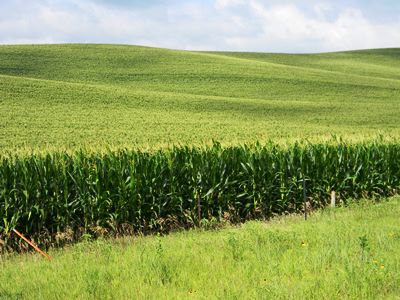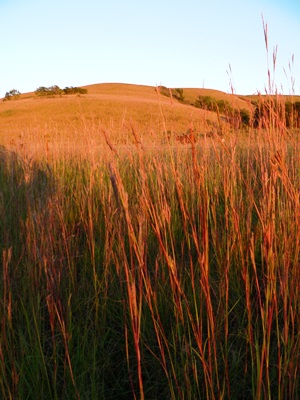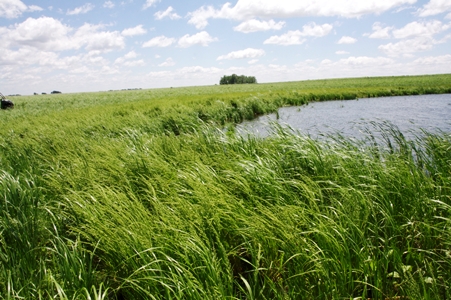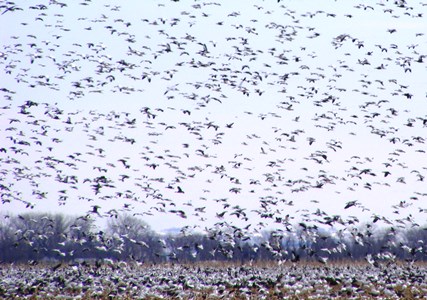It’s brisk and moist on an overcast autumn afternoon in northeastern South Dakota. The earth is muddy from last night’s rain and sleet, but preparation for next spring’s planting is already underway. Cattle grazed a grassy pasture here last summer. Next summer, these acres will be growing corn.
I am watching a heavy-duty tandem disc break virgin prairie. Across the width of this implement are double rows of circular harrow blades, each one bigger than a dinner plate. The blades revolve over and over to penetrate and turn the ground. The tandem disc is towed by a tractor that runs on tracks instead of tires, and it easily moves across the land despite sticky, slippery conditions.
A man operating a nimble rock picker is plucking stones from unplowed areas. A growing pile of rock along a fence line on one side of the field is the collection point for the fruits of his labor. A dump truck, its bed filled with boulders, is mired down in mud. The driver accelerates and tires spin. He idles the engine and waits for the rock picker to pull him free. Then he’ll dump his load and return for more.
As I watch the dump truck rocking back and forth in the mud, I spot a colorful stone poking through unplowed earth. I grasp the top, wiggle it, and finally pull it free. Like an iceberg, there’s more below the surface than above. It’s sizeable — as big as a cantaloupe — and I stow it in my pack. I’m a rock collector, and I save notable stones as mementos from trips across the country.
The tractor and disc clatter by, making another long trip across the land. Behind them, native sod is neatly sliced and turned on its side or upside down in long strips. There is symmetry to the six-inch-deep cuts and the slabs of exposed soil, with glistening green grass on one side and dark dirt on the other.
The plan is to wait a week or so after the disc’s first pass on this 160-acre quarter section — which will allow soil, grass, and other vegetation in the broken sod to dry and start to decompose — before cross-disking the entire tract. “The more decay, the better the tear-up,” explains the landowner as he walks me through the process of converting native grassland to monoculture crop production.
After the disc is used a second time, more rock picking and digging will be done. Stones resting on the disked sod or partially buried near the surface of the soil can break a high- priced seed planter. In this part of the world, rock removal is a vital part of prairie conversion. A third disking after that is an option.
The final step in the conversion process involves an implement — one version is called the Turbo-Till® — that in a single pass chops residual vegetation and creates a smooth, consistent seedbed.
In a matter of several weeks, a prairie that evolved over thousands of years will have been completely and irretrievably undone. Corn planting will take place in five months or so.
This conversion is happening on mixed-grass prairie along the western fringe of today’s corn belt. Not too many years ago, pasture management and cattle grazing dominated land use here. This is also the heart of the prairie pothole region, known as North America’s “duck factory” due to the critical nesting and breeding habitat it provides for many species of far-ranging waterfowl.
It was the presence of so much stone that helped keep this land in grass. Uncertain precipitation and a shorter growing season than the rest of the corn belt also figured into land-use decision-making. New corn hybrids have allayed grower concerns about rainfall and climate, and these technological achievements dove-tailed with exploding corn prices, aided by ethanol’s appetite for more and more corn.
 When grain prices rose to remarkable heights, land values also increased — often at a jaw- dropping rate. Just 20 years ago, this rocky property was valued at hundreds of dollars per acre. Today, an acre of land like this fetches $3,000 to $4,000 from corn farmers expanding their operations as quickly as their income and credit allow. Farm sizes are multiplying, and the temptation to transition from cattle to corn has become almost irresistible. Tax and land-use policies as well as incentives offered by lending agencies and institutions — all driven by high corn prices — also encourage the conversion of grasslands to grain.
When grain prices rose to remarkable heights, land values also increased — often at a jaw- dropping rate. Just 20 years ago, this rocky property was valued at hundreds of dollars per acre. Today, an acre of land like this fetches $3,000 to $4,000 from corn farmers expanding their operations as quickly as their income and credit allow. Farm sizes are multiplying, and the temptation to transition from cattle to corn has become almost irresistible. Tax and land-use policies as well as incentives offered by lending agencies and institutions — all driven by high corn prices — also encourage the conversion of grasslands to grain.
Now, volatility in corn prices — from near $8 a bushel last year to less than $4 as of this writing — is pushing farmers to seek high returns through volume. Inputs such as seed, fuel, fertilizers, and biocides remain spendy, shrinking per-acre profits and causing corn producers to expand the amount of land they plant to maintain revenues.
The landowner managing the conversion project I witnessed was reluctantly doing so. “This wasn’t part of my original plan,” he said with a noticeable sigh. “I’d rather have cattle, with the land in pasture.” His land ethic was more nuanced and sensitive than I ever would have guessed. “Unfortunately, my circumstances dictate doing this,” he added, before elaborating with a personal story about his life and his finances.
Not all farmers and grassland ranchers face the same challenges or express the same sentiment as the fellow I met. But the story of prairie conversion, no matter why or where, reveals an ongoing trend in agriculture that has less to do with stewardship and sustainability and more to do with the here and now of individual farmers taking advantage of business opportunities, including engaging in land-management decision-making focused by necessity on a bottom line that is determined by people residing far from our farmlands.
Perspective
So much of what we do as a society begins with and results from what we choose to do with precious, irreplaceable land resources.
The American conservation movement has engaged in a variety of meaningful causes. Strip mining, clear cutting, dam building, well drilling, mountain top removal — each is a landuse issue warranting serious public discussion and scrutiny. But the systematic extermination of prairie, especially tallgrass prairie, has been a relatively quiet occurrence, and it has proceeded despite the efforts of a cadre of worried and enlightened activists.
North America’s grassland prairies — tall, mixed, and short grass regions — once stretched from Ohio to the Rockies and from Manitoba to Texas. Comprising more than 1.5 million square miles — that’s 15 percent of the continent’s land mass — grasslands were our most prevalent type of vegetation. From an ecological perspective, grasslands provide a blend of habitats that nurture hundreds of species of flora and fauna. Sportsmen understand the biological value of grasslands for upland birds. They also know that the related wetlands in the prairie pothole region are essential to healthy waterfowl populations throughout the continent. Grasslands and wetlands provide other significant environmental benefits, including biodiversity, water quality protection, aquifer recharge, flood control, soil maintenance, and carbon storage.
Unfortunately, we are entering what could be a death knell for tallgrass prairie. Less than one percent of the continent’s tallgrass prairie now survives. Prospects for saving crucial tracts of remaining tallgrass prairie — particularly grasslands owned by the private sector — are iffy, and recovering tallgrass through restoration hinges on landowners applying dramatically different approaches and considerations to land use.
From Grasslands to Grain Field
Arriving at this ecologically tragic juncture in our history was not an overnight occurrence.
 In the early 1800s, those brave enough to creep from the Appalachians onto the open, sun-soaked spaces of the North American prairie found fertile soils and hardly a rock to trip over. A thick tangle of grasses and forbs were anchored to rich sod, but an ox, a steel plow, and plenty of back-breaking labor could clear a modest field for planting saleable crops.
In the early 1800s, those brave enough to creep from the Appalachians onto the open, sun-soaked spaces of the North American prairie found fertile soils and hardly a rock to trip over. A thick tangle of grasses and forbs were anchored to rich sod, but an ox, a steel plow, and plenty of back-breaking labor could clear a modest field for planting saleable crops.
The easternmost portion of the grasslands — the tallgrass prairie stretching from Ohio to Dakota Territory — was homesteaded by ambitious settlers throughout the 19th century. Farming intensity continued, and by the close of the 20th century, only 10 percent of the continent’s tallgrass prairie remained — a loss of native landscape measuring more than 150 million acres. Today, just 13 years later, those remnant and rare prairie lands are almost gone.
Consider the status of tallgrass prairie in Illinois. Pre-settlement perennial grasslands within what are now that state’s boundaries measured 22 million acres. Today, only about 2,000 acres remain — less than one-hundredth of one percent. Iowa once held 29.5 million acres of tallgrass prairie; less than 30,000 acres now exist in scattered preserves and pastures. In neighboring Minnesota, 18 million acres of tallgrass could once be found; today there are only about 230,000 acres.
The grim truth is that tallgrass prairie is the continent’s most endangered ecosystem. In its place are grain fields that symbolize America’s position as the world’s leader in agricultural productivity. While this land swap started a century and a half ago, it dramatically increased over the past decade, and we are now left to wonder whether such a land-use trade — so much prairie for so much corn and soybeans — has been worth it.
Documenting Loss
Dr. Christopher Wright and Dr. Michael Wimberly of the Geographic Information Science Center of Excellence at South Dakota State University released a report earlier this year that quantified the recent rate of prairie loss. The two researchers interpreted land cover data to assess grassland destruction in the western region of the modern corn belt. Their findings indicated that grassland cover in that area declined by more than 1.3 million acres from 2006 to 2011. Wright and Wimberly concluded that this reduction was due to expansion of fields planted to corn and soybeans. Not since the 1920s and 1930s, wrote Wright and Wimberly, has prairie been so rapidly destroyed.
Wright also reports that the conversion of prairie to row crops is happening not only to lands within the core area of the corn belt, but that the corn belt is pushing outward as well. According to the two researchers, this is most evident in southern Iowa and the eastern Dakotas, where lands formerly used to grow grass are now producing corn. This type of land conversion is precisely what I witnessed.
Research by Dr. Carol Johnston adds more concern for those who understand prairie’s ecological importance. Johnston, a professor at South Dakota State University, studied the conversion of prairie wetlands in the prairie pothole region to croplands. She determined that during the past decade, wetlands in the region have been destroyed at a rate of 15,300 acres per year, and she cited high commodity prices and a significant drop in the number of acres enrolled in the Conservation Reserve Program (CRP) as key factors. The rate of wetland destruction, cautions Johnston, is increasing.
Research also shows that between 1986 and 2000, tile and drainage applications and permits issued to farmers in the prairie pothole region of eastern North and South Dakota were relatively rare. But starting in 2001, applications sharply accelerated, and they’ve remained noticeably high. Between 2008 and 2011, for example, permits for tile and drainage projects to convert prairie wetlands to croplands numbered more than 500 per year in just the eastern Dakotas.
Prairie, Profits, and Other Considerations
Dr. Carter Johnson and I are hiking into a stand of switch grass higher than our eyes. The soft whisper of a slight breeze can’t obscure the steady sounds of singing birds and buzzing insects. Frogs croak, herons squawk. Overhead, a bright blue sky provides a background for waving grasses. So this is tallgrass, I think to myself. It feels dynamic and natural.
But it’s really a farm.
Johnson is an ecologist at South Dakota State University, and these days he’s also a farmer with his eye on hay, beef, and seed prices. Six years ago, dismayed by disappearing native prairie and hoping to provide an antidote to that environmental ailment, he and several colleagues founded an ecological-agricultural enterprise called EcoSun Prairie Farm.
On 640 acres of land in southeast South Dakota that had prodigiously grown corn and soybeans for a century, Johnson and his fellow scientists cleared off the grain and began a careful process of restoring the land with indigenous plants. Their mission was far more sophisticated than simply growing and preserving tallgrass prairie.
 “This isn’t a nature preserve,” emphasized Johnson, as we toured EcoSun’s bountiful, beautiful fields. “This is a working farm that grows native, perennial grass instead of corn or soybeans.” Johnson motioned to diverse grasses, pointing out sedges, wedge grass, bluestems, and a dozen others. Flowering forbs color the landscape with purples and yellows. He shows me fields that are rich in mixtures and diversity of grasses and forbs, like the land naturally produced before row crops changed everything. On the spongy soil bordering wetlands, cord grass prospers. At EcoSun, wetlands drained and filled by previous farmers are being restored, and these offer yet another setting on the farm where Johnson utilizes natural conditions to grow optimal grasses. Researchers are determining which grasses or combinations of grasses best benefit from the farm’s various wetland and upland environments. More than a hundred species have taken root and are flourishing.
“This isn’t a nature preserve,” emphasized Johnson, as we toured EcoSun’s bountiful, beautiful fields. “This is a working farm that grows native, perennial grass instead of corn or soybeans.” Johnson motioned to diverse grasses, pointing out sedges, wedge grass, bluestems, and a dozen others. Flowering forbs color the landscape with purples and yellows. He shows me fields that are rich in mixtures and diversity of grasses and forbs, like the land naturally produced before row crops changed everything. On the spongy soil bordering wetlands, cord grass prospers. At EcoSun, wetlands drained and filled by previous farmers are being restored, and these offer yet another setting on the farm where Johnson utilizes natural conditions to grow optimal grasses. Researchers are determining which grasses or combinations of grasses best benefit from the farm’s various wetland and upland environments. More than a hundred species have taken root and are flourishing.
“It’s a different way to look at grass rather than planting it and letting it sit,” Johnson says. “We decided to plant it and put it to work — and make some money off it while we’re also benefiting the environment. We think it’s a win-win deal. We look at this as an example for others to follow, as a farming option that both protects resources and provides income.”
Typically, tallgrass prairie survives or is restored on marginal lands or in small parcels that are treated like precious heirlooms or as wildlife sanctuaries. Fields like the ones at EcoSun are usually off-limits to prairie restoration because growing corn or soybeans is the conventional approach to using fertile lands.
The biggest challenges to demonstrating the viability of the EcoSun farm, said Johnson, are public perception and economic issues. “Many people,” he explained, “believe that land left in grass is land not used to its fullest. Of course, we believe such a viewpoint needs to change. Just as important, we’re proving that a farmer can make a living with grass and doesn’t need easements, CRP, or price supports. We’ve also learned that a farmer must be very entrepreneurial to make a grass farm work financially. You have to have multiple income streams, just like traditional farms had.”
Those income streams at EcoSun include the sale of seed, hay, and grass-finished beef. Seed sales have been reliable and brisk, and hay sales benefitted from dwindling grass supplies in the region. A small herd of cattle feed on EcoSun’s rich pastures, creating a flavorful yet lean beef that is popular in progressive markets and served in top-quality restaurants. This year’s profits, says Johnson proudly, are very encouraging. “Our net income from this farm can support a family of four.”
Understanding the Loss
Johnson says the best way to understand what is lost when prairie is plowed is to understand what is gained when prairie is saved or restored. “The minute you plant grass, the advantages begin to accrue,” he explains. “Preventing soil erosion and protecting soil fertility are primary advantages. Tillage or even no-till have higher erosion rates than perennial grass farming, and this is especially true when you compare conventional tillage. There’s less runoff with grass, and that means precipitation and water stay on the land and move through the plants — and not run off carrying soil into surface water. Grass also protects groundwater because you use few or no fertilizers and biocides. Everything you look at that has any connection to the environment is better off with grass versus row crops.”
According to Johnson, when prairie is plowed the negative impacts begin immediately. Carbon and organic matter in the soil — components of biomass and fertility — instantly decline as they are exposed to the elements. Johnson explained that “half the soil carbon in the land now managed by EcoSun was lost before we started our operation because of previous plowing and row crop practices.” Wetland areas on the property that were drained and filled lost two-thirds of their carbon, Johnson added. “We’re recovering some of what was lost,” he said, “but unfortunately, once a prairie has been plowed, some losses are irretrievable.”
Not only is the natural fertility and health of the land diminished when prairie is plowed, exposed carbon can rise into the atmosphere, exacerbating climate change. One study conducted by the United Nations concluded that corn and other biofuel crops grown on plowed grasslands fail to achieve a net reduction in greenhouse gasses due to CO2 emissions that occur when the grasslands are destroyed. Landuse practices, such as plowing grasslands, rank as the second leading cause of climate change.
 Of course, losing grasslands is also harmful to wildlife. Bird species relying on grasslands are losing populations faster than birds elsewhere. Seventy percent of the grassland birds monitored by the National Breeding Bird Survey have declined significantly during the past 30 years. Important yet obscure prairie species like the Dakota Skipper butterfly and Topeka Shiner minnow have practically disappeared. More prominent grassland species that aren’t indigenous, such as the Ring-neck Pheasant, are also faltering as habitat shrinks. This autumn, South Dakotans were dismayed when researchers revealed that the state’s pheasant numbers had dramatically dropped. In a state where corn production and pheasant hunting are drivers of economic prosperity, it is now clear that you can’t have lots of one without sacrificing lots of the other.
Of course, losing grasslands is also harmful to wildlife. Bird species relying on grasslands are losing populations faster than birds elsewhere. Seventy percent of the grassland birds monitored by the National Breeding Bird Survey have declined significantly during the past 30 years. Important yet obscure prairie species like the Dakota Skipper butterfly and Topeka Shiner minnow have practically disappeared. More prominent grassland species that aren’t indigenous, such as the Ring-neck Pheasant, are also faltering as habitat shrinks. This autumn, South Dakotans were dismayed when researchers revealed that the state’s pheasant numbers had dramatically dropped. In a state where corn production and pheasant hunting are drivers of economic prosperity, it is now clear that you can’t have lots of one without sacrificing lots of the other.
Declining habitat in the prairie pothole region should alarm birdwatchers and waterfowl hunters across the nation. Recent research shows that waterfowl relying on grassy cover and prairie wetlands in the pothole region migrate to at least 31 states, 4 Canadian provinces, 4 Caribbean countries, and 8 countries in Central and South America. This remarkable reach of marshes and sloughs in the prairie pothole region reveals that a reduction in these wetlands will influence waterfowl numbers across two continents.
On Johnson’s prairie farm, work is underway to restore more than 30 wetlands. The combination of grassy uplands and shallow ponds offers a wide variety of wildlife a chance to flourish. Not only is the habitat welcoming, but the use of harmful synthetic fertilizers, herbicides, and insecticides on EcoSun farm is practically zero. There’s little or no need for them there — or, for that matter, on any perennial prairie.
Distance and Time Reunited
It is two hundred miles from where I watched a grassland being plowed to where EcoSun restores — you might even say “un-plows” — prairie.
On the prairie being broken, I had reached down and collected a colorful stone left by a retreating glacier 10,000 years ago. How else, I marveled, is it possible to hold in my hand a fragment of earth a billion years old? The plowed soil — glacial till made more fertile by an endless cycle of plants growing, dying, and decomposing — had a rich, organic smell. It’s far younger than the stone, but it’s alive. And it’s been dug up, turned over, and exposed to the sky for the first time in its lifetime. I felt I’d saved that stone from being dumped on a pile of rubble near the broken field, keeping it for a more dignified place on a decorative rock wall bordering my backyard garden.
Not long after that, I am traveling once again to EcoSun. On the front seat, I have that handsome rock of red and gray. A stone-stacked wall seems inappropriate when a better option is available. No one is there when I drive the gravel road that fronts EcoSun’s southern boundary. Near that road, on the edge of the prairie farm, is a small drainage with fieldstone scattered about. I’m not romanticizing rocks or land or soils or grasses. But it felt right when I rolled that stone onto EcoSun’s prairie.
Peter Carrels writes articles and essays from South Dakota. His critically acclaimed book, Uphill Against Water, profiles the protracted, bitter conflict between a remarkable grassroots group and the political and business establishment, which led to a transformation of federal water policy in the West.